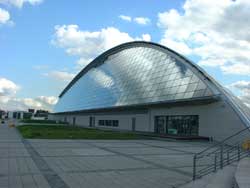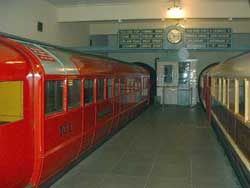|
|
TOURISM - SCOTLAND CENTRAL |
CITY OF GLASGOW |
Glasgow, ‘Glas Cu' the ‘Dear Green Place' the very interpretation of the name would suggest that Glasgow then was very different from the place we now know. Glasgow , although not the capital of Scotland is however its largest City. It is a sprawling Metropolis of just under 1,000,000 people who live and work there on a daily basis. Glasgow has a history stretching back to earliest times. The banks of the River Clyde are steeped in history, and just waiting to be discovered. Stone Age canoes unearthed along the banking suggest early fishing communities lived on the banks of the then small river. |
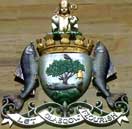 |
| It has been suggested that Celtic Druids were probably the first recognisable religious people to inhabit the place. |
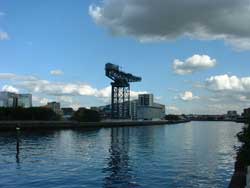 |
Glasgow then would have been known by its ancient title, Cathures. This settling period would have been in approximately 80AD. So Glasgow has been in existence for a very long time. The name Glasgow is famous all over the world for many different reasons. In more modern times it was because of the violence and crime associated with this huge place that brought it to the attention of the world. Shipbuilding and ‘Clyde Built' was the other side of the coin. Saint Kentigern/Mungo, James Watt, The Tobacco Lord, John MacLean, the Red Clydesiders, Alexander Fleming, Sir Alex Fergusson, Billy Connolly and of course their two most famous football teams, Glasgow Rangers and Celtic (who became the first British team to win the European Cup in 1967), made this city into one of the most vibrant in the world today. |
The Roman legions visited Glasgow and would more than likely have traded there with the local merchants. In the year 143 AD the Romans erected the turf-built Antonine Wall stretching from the Clyde to the Forth to separate Caledonia to the north from Britannia to the south, but the wall was soon abandoned. The first well-known Christian to visit the place was St. Ninian, in approximately 380 AD, and it would be another 160 years or more before the coming of St. Kentigern in the sixth century. Kentigern had been exiled from Culross where his miracle working had aroused jealousy and hatred among his monastic brothers. |
He came to Glasgow and established a church on the banks of the Molendinar Burn, which is now the site of Glasgow cathedral. Kentigern was to have a change of name. The people of Glasgow who called him ‘Mungo' gave this new name to him. The meaning of Mungo was ‘Dear One'. St Kentigern or Mungo was accredited with performing four miracles in the city, and these miracles are depicted in the City of Glasgow coat of arms. There is also a rhyme that goes with it. Here's The Tree That Never Grew |
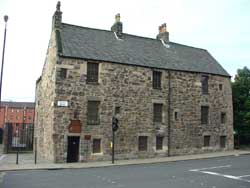 |
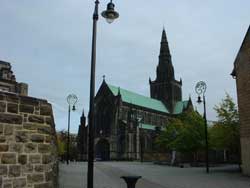 The illustration here is of an ornate lamppost, incorporating all the symbols of the coat of arms. It is located near Glasgow Cathedral - founded nearly 1500 years ago by St Mungo. |
The Tree That Never GrewThe tree in the coat of arms is a now sturdy oak tree, but it started out as a branch of a hazel tree. The legend says that St Mungo was in charge of a holy fire in St Serf's Monastery and fell asleep. Some boys who were envious of his favoured position with St Serf put out the fire. But St Mungo broke off some frozen branches from a hazel tree and, by praying over them, caused them to burst into flames. The Bird That Never Flew This commemorates a wild robin which was tamed by St Serf and which was accidentally killed. St Mungo was blamed for the death but he is said to have taken the dead bird, prayed over it and it was restored to life. |
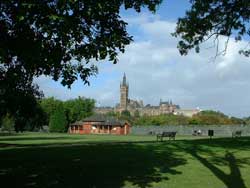 |
The Fish That Never SwamThe coat of arms always shows the fish with a ring held in its mouth. This is because a King of Strathclyde had given his wife a ring as a present. But the Queen gave it to a knight who promptly lost it. Some versions of the story say that the King took the ring while the knight was asleep and threw it in the river. The King then demanded to see the ring - threatening death to the Queen if she could not do so. The knight confessed to St Mungo who sent a monk to catch a fish in the river Clyde . When this was brought back (presumably catching salmon in the Clyde in those days was a lot easier then!) St Mungo cut open the fish and found the ring. When the Bishop of Glasgow was designing his own seal around 1271, he used the illustration of a salmon with a fish in its mouth and this has come down to us in today's coat of arms. |
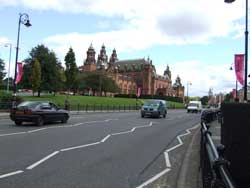 |
The Bell That Never RangIn 1450, John Stewart, the first Lord Provost of Glasgow , left an endowment so that a "St Mungo's Bell " could be made and tolled throughout the city so that the citizens would pray for his soul. The bell was still ringing out in 1578, as there is an entry in the City Treasurer's accounts two shillings (10p) "for one tong to St Mungo's Bell ." The magistrates purchased a new bell in 1641 and that bell is on display in the People's Palace museum near Glasgow Green. |
When Mungo died on 13 January 603AD he was buried in his own church. Mungo's original church was destroyed by the wars, which swept the country in the years after his death. In the years between Mungo's death and Glasgow 's establishment as an Episcopal centre in 1145, there is very little information available about the history of the city. Today's Cathedral dates from the 12th Century and has been added to in the years that followed. Provands Lordship the oldest house in Glasgow was built over 500 years ago for the Lord of Provan, an official of the Cathedral. The house still welcomes visitors today to view its proud history. |
In 1451 Glasgow became a University City . Glasgow University was originally built in the High Street area of the city, but was moved to its present site in Glasgow 's West end in 1870. Glasgow has also been the site of many battles. Bishop's Castle once stood on the site now occupied by Glasgow 's Royal Infirmary. Here, in 1300, William Wallace (of "Braveheart" fame) with 300 men defeated an army of 1000 English Knights who had taken possession of the castle under the English Bishop of Durham . |
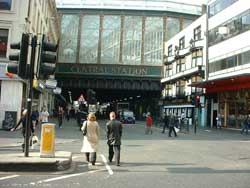 |
Two centuries later the castle was again the scene of battle when two opposing forces fought for control of the Crown of Scotland then in the possession of the baby, Mary Queen of Scots. Glasgow was situated on a prime spot for developing the new markets that opened up worldwide. America was attainable from the port as was the West Indies and all other trade routes. This was the age of the ‘Tobacco Lords' who made vast fortunes, from rum, sugar and of course tobacco. They built huge sprawling houses in the best areas of the city, and lived like kings. The poor of Glasgow however were being forgotten. Housing in that era was deplorable and most people lived in one-roomed houses known locally as ‘Single Ends' this was social deprivation at its worst. There was however a feeling of oneness, and belonging with the people who lived in these conditions and they went forward with an amazing community spirit. It was soon discovered that Glasgow and the surrounding areas were a rich source for coal and ore and this opened up a whole new window of opportunity for the city. This discovery was to shape the way the city would progress for the next two or three hundred years. |
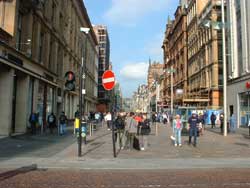 |
With the coming of the Industrial Revolution, aided by technological advances designed by Clydeside inventors such as James Watt, Heavy Industry in the shape of Railway Locomotives and Shipbuilding flourished. Locomotives were exported throughout the world. "Clyde-Built" became synonymous with quality and reliability. The launch of the three " Queens " - luxury passenger liners - was the pinnacle of Glasgow 's shipbuilding achievement. Sadly due to the economic crisis affecting today's world, shipbuilding on the banks of the Clyde has almost died out. There are still exceptions and a few companies still make a living doing the old trade but most of the really huge shipbuilding companies have long ceased to exist. |
Glasgow as a City has developed well into the 21 st century. Towards the end of the 20 th century the face of Glasgow began to change. Out went the ‘No Mean City' look and in came a new modern, more tolerant place to live. In 1989, Glasgow as given the Garden Festival and it was an amazingly spectacular success for the city which in the past had been known for its lack of culture among the people. 1990 saw the city adorned as the European City of Culture and in the year 1999 Glasgow hosted the Festival of Architecture and Design. Today Glasgow , ‘the dear green place' welcomes and embraces tourists from all over the world. Glasgow 's art treasures are world-renowned and most of the city's museums and art galleries offer free entrance to view their treasures. Kelvingrove Art Gallery and Museum has just received a two-year facelift and is looking magnificent. The city has a wonderful Concert Hall, International Conference Centre, Science Centre, Sports Arena and shops rivalling the best in the land. Glasgow now has everything, a friendly helpful population, who welcome visitors to their city and are proud to claim that they are Mungo's people, and true Glaswegians. Glasgow 's current motto; “Let Glasgow flourish by the preaching of His word and the praising of His name” Often abbreviated to the more secular “Let Glasgow flourish” Is inspired from His original call to "Let Glasgow flourish by the preaching of the word". |
Glasgow's museums include:
|
| The Mitchell Library is the largest public reference library in Europe. Scotland's leading cultural institutions, Scottish Opera and the Royal Scottish National Orchestra are based here and the city also has a longstanding and lively popular music scene based around venues such as the Barrowlands and King Tut's Wah Wah Hut. |
||
Glasgow has a number of theatres, includng:
|
||
|
||
Amongst the city's parks are:
|
| The city was host to the two Great Exhibitions of 1881 and 1901. More recently it was European Capital of Culture 1990, National City of Sport 1995-1999, UK City of Architecture and Design 1999 and European Capital of Sport 2003. |
The Full List
|
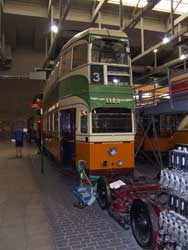 |
 |
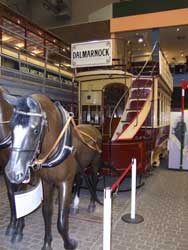 |
Images from the Transport Museum |
|

